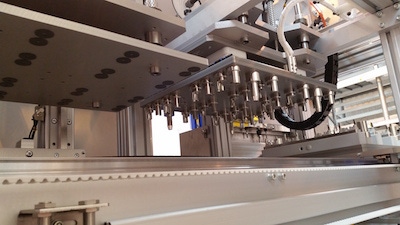Technology optimizes automated, high-speed leak detection of critical medical parts
July 25, 2016

Developer of injection molding automation systems DB-Automation (Broughton Astley, UK) recently was tasked with building a 32-cavity injection mold tool for a medical device manufacturer. A key requirement from the OEM was that the tooling contain no holes or faults that would undermine the integrity of the sterile plastic component that was being molded. The company turned to leak detection specialist Dyne Technology Ltd., based in Lichfield, UK, to source a solution.
This was a challenging task, notes DB-Automation, as 32 injection molded parts had to be thoroughly and simultaneously checked across a single plate. The cycle times and quantity of components undergoing simultaneous testing ruled out the use of conventional flow and pressure decay tests. DB-Automation’s Operations Director Nick Parker recalled seeing a technology that might work.
“During visits to clients over the years, I have seen many state-of-the-art technologies with very interesting applications. Some time ago, I came across a company using an electric current to perform a leakage test and, with this in mind, I set out to find the perfect solution,” said Parker.

Parker contacted surface treatment specialist Dyne Technology Ltd. (Lichfield, UK), which recommended the LeakTEC system, a nondestructive leak-detection method developed by Tantec (Lunderskov, Denmark). The Dyne Technology team worked with Tantec, experts in industry-leading surface modification, surface cleaning and leak detection solutions. Its LeakTEC technology for inspecting plastic components proved to be the perfect solution for us, said Parker.
Thorough trials were conducted at Dyne Technology’s laboratory facilities in Lichfield and from this, LeakTEC was proven as the best method for the customer. LeakTEC has the ability to detect micron-sized holes within plastic components in fractions of a second and can do this across multiple products simultaneously, said DB-Automation.
How LeakTEC works
LeakTEC measures leaks between a high-voltage electrode (DC) and counter electrode, which can either be grounded or running in opposed polarity. Full process control and traceability are ensured, said Tantec, making it suitable for surface testing molded and welded joints in an array of medical components and products including tubing, containers, pipettes, cannulae and extruded film.
The fully automated test is capable of detecting pin holes even smaller than 3 microns by introducing an electrical potential between a detecting electrode and an electrical ground, such as a metal jig or mandrel holding the part, while the plastic part itself acts as the insulator.
When a crack or pin hole is detected in the plastic material, an electrical contact is established between the electrode and ground. The pass/fail contact is processed via the integrated generator module, which is interfaced with the main machine control. The machine control can either enable a downstream part-reject function or track trends in the manufacturing process, which can be fed back for early process adjustment or maintenance. Counter electrodes measurement ensures that all electrodes are fully working. Each counter electrode will then give out an individual signal to be processed by the machine's PLC.
To limit high voltage and minimize generation of static electricity, Tantec offers a patented dual polarity system.
DB-Automation worked closely with both Dyne Technology and Tantec technical experts to produce the tooling. The final build consisted of a dedicated high-speed side-entry beam robot to de-mold the product from the tool, which takes less than one second. The beam robot then hands the part to a take-off unit, which repositions the product and places it onto a high-speed transfer axis to provide movement from the put-down position to the testing station and onward to the unload and segregation area.
All 32 components from every mold cycle are inspected for leaks and rejected, if necessary. The system is capable of processing almost 16,500 parts per hour at a 100% inspection rate, with little or no operator intervention.
About the Author(s)
You May Also Like




